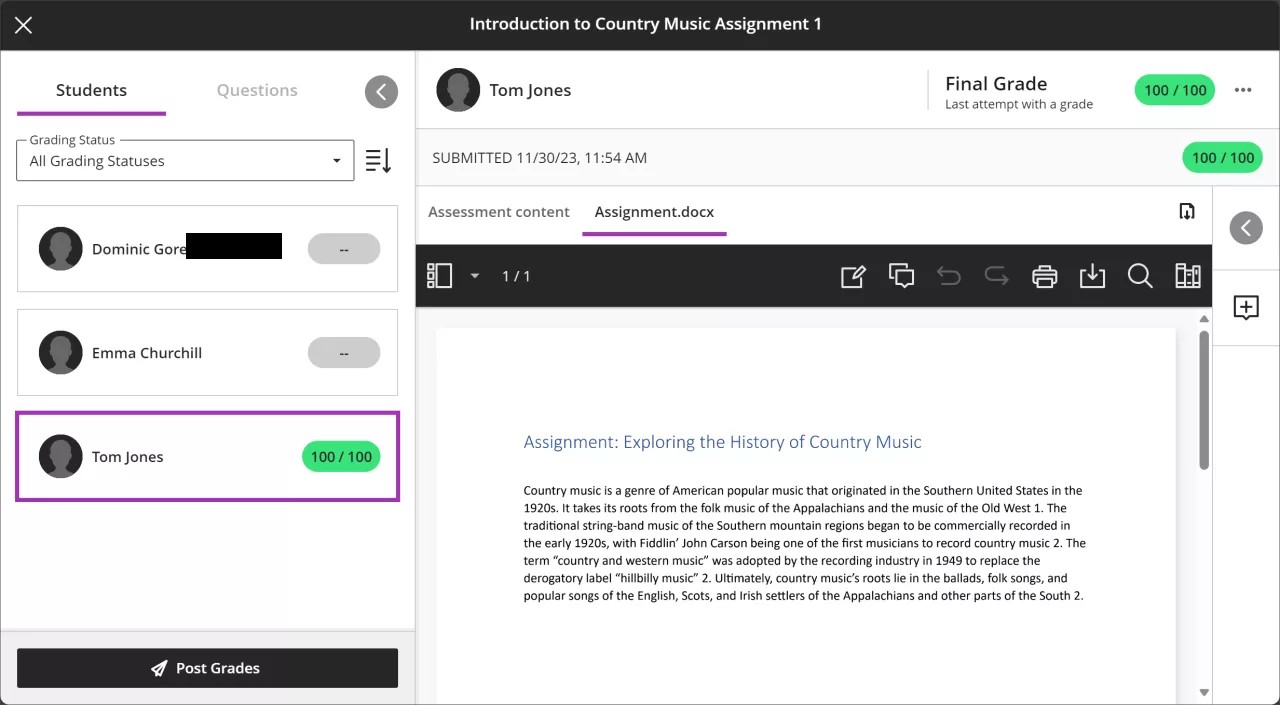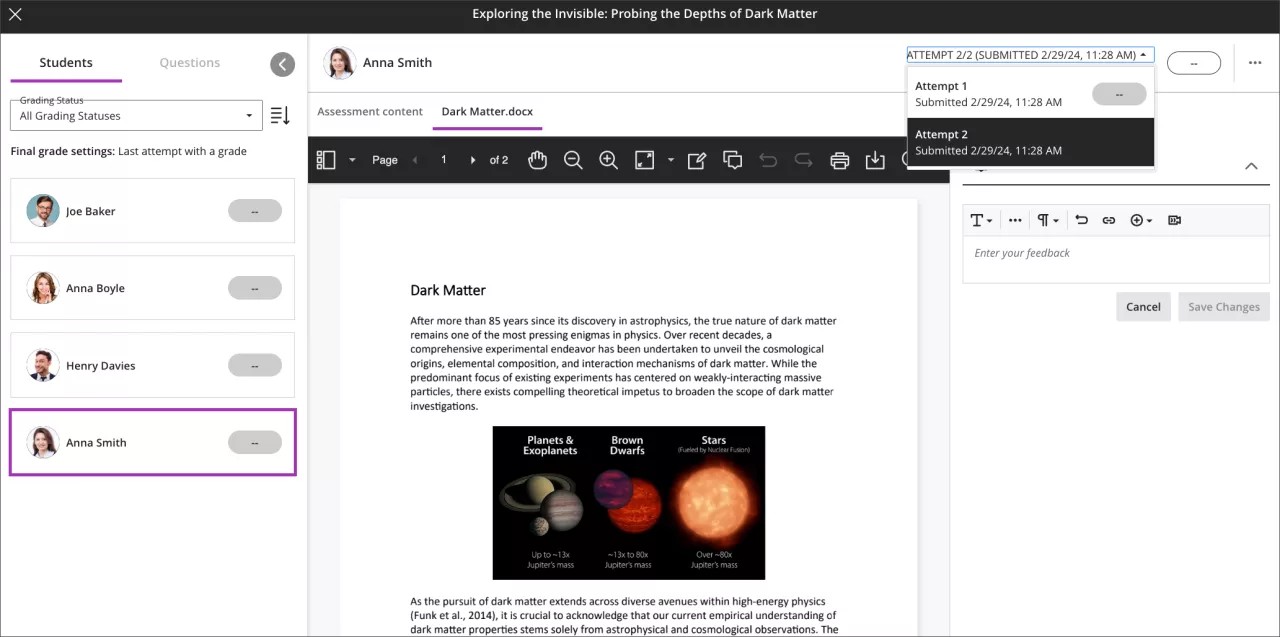Flexible grading is an optimized grading experience that provides instructors with the flexibility to grade in their preferred style. With flexible grading, you can:
- Easily review the status of your grading tasks and prioritize your time where it is needed most.
- Provide inline, multimedia feedback direct to students.
- Easily access grading rubrics, anti-plagiarism checkers, and more as you work through your grading tasks.
Where do I start grading?
You can start grading from four areas:
Grades page. The Grades page provides immediate access to all your courses' grading tasks. From the navigation bar, select Grades. On the Grades page, grading tasks are organized by course, so you can quickly scan your progress, set priorities across the board, and even begin grading. No need to navigate to each course to see what's ready for grading.
The page only displays information if you need to take action. You see assignments that are ready to grade or overdue for students.
- Activity stream. You're alerted when student submissions are ready for grading. Select the link to go directly to the Submissions page for the assignment. The Submissions page is filtered is filtered to only show students who need grading.
- Submissions tab of an assignment. When you access an assignment, the Submissions tab displays all students enrolled in your course. You can search for a student by name or student ID or use the Grading Status filter to display only those submissions that need grading.
- Gradebook. From a course, select Gradebook on the navigation bar. You can choose a gradebook view:
Grades view
From the Gradebook, select Grades. You can view your roster of students who submitted new work. When a student has a new item to grade, select New Submission, View to access the grading page for the submission.
Gradable items view
From the Gradebook, select Gradable Items. You can sort assignments in this view by Grading Status. Graded work is labelled All Graded or Complete. Select the name of the assignment or X to grade to access the Submissions page. The Submissions page will have the Needs Grading filter applied. Select a student name to start grading a submission.
Students view
From the Gradebook, select Students. You can view all students in the course. To grade assignments for a student, select their name.
Grade an assignment submission
Select an assignment to grade to access the Submissions page. Then select a student to open the grading page.
From this page, you have several options:
Students panel
- Expand the Students panel to view the list of students who submitted an assignment. Collapse the panel to view more of the submission.
- Use the Grading Status filter to display all students or select the Needs Grading filter to focus on remaining grading work.
- If a student has accommodations, a purple pill appears next to their name.
- If a student has late submissions or the due date passed with no attempt submitted, a red circle appears around their profile picture.
- When ready, you can select Post Grades to post grades for all graded students.
If you enabled anonymous grading, all student names are masked.
Grade information
- If the assessment is configured to allow multiple submission attempts, you can select which attempt to grade.
- After grading, you can view grades for each attempt and the final grade for the submission.
- Use the menu next to the final grade to post the student's final grade or delete their attempt.
Submission information
- View the submission receipt number and time stamp.
- Use BB Annotate options on the menu bar for inline grading & commenting of the submission.
- Show or hide the assessment content displayed to a student when they attempt a submission.
- If the student submitted more than one file, they appear on separate tabs you can move between.
When grading from a tablet, only one of the side panels will be open at any time. Accessing one panel will collapse the other.
You can collapse or expand the left and right panels; the application remembers these preferences for your next session.
Feedback panel
- Expand or collapse the feedback and rubrics side panel to add feedback for the attempt or grade with a rubric (if one is available).
- When you post grades, students can view feedback you provided for each attempt, including ungraded attempts.
- You can embed an audio or video recording of your feedback in the editor as you grade attempts. The recording option appears in the feedback editor for most graded items in your course. Students watch or listen to your feedback alongside any text you include.
This feature isn't supported on all browsers. For the best experience, use Chrome or Firefox.
Grade an assignment with multiple attempts
When you create an assignment, you can choose to let students submit more than one attempt. Multiple attempts change how the assignment's final grade is automatically calculated. Choose how you want to calculate the final grade:
- Average of all attempts
- First attempt with a grade
- Attempt with highest grade
- Last attempt with a grade
- Attempt with lowest grade
If the student has made multiple submission attempts, you can select which attempt you want to grade. In the attempt dropdown menu, you can view the attempt number, the submission time stamp, and the grade for each submission made.
You can't allow multiple attempts on a group assignment or when you collect submissions offline.
The Grade attempts setting determines how the final grade is automatically calculated, but you have the option to override the final grade. Each attempt is subject to the due date you set for the assignment. If a student submits an attempt after the due date, the attempt is marked late. Attempts submitted before the deadline are shown as on time.
You can only override the final grade, not the grades for each attempt. If you assign an override grade without grading the student's first attempt, the attempt displays a Needs Grading status. An override label appears next to the grade.
Learn more about the ramifications of overriding grades
When you post grades, students can view them and any feedback you provided. All feedback for all attempts, even ungraded attempts, shows to students. If you used a rubric or questions that are scored automatically, the grade may already exist for the attempt.
Final grades
The final grade for a multiple attempt assignment is calculated based on the Grade Attempts setting you chose in the Assignment Settings. In the panel that lists a student's attempts, the final grade appears when those attempts are graded. For example, if the final grade is calculated based on the highest graded attempt, the final grade appears immediately after at least one attempt is graded. However, the grade may change as you continue grading more attempts. After you finish grading the attempts, you can post the final grade for the student to see.
What do students see?
Assignments with multiple attempts list the number of attempts allowed, as well as how the final grade is calculated. Students view this information on the Details & Information page before they begin. When grades are posted, students can view grades for each of their attempts, as well as the final grade. If you decide to override the final grade, a message appears to let the student know.
Grade an assignment with a time limit
When you allow students to work past the time limit for an assignment, you're able to view which assignments exceeded the time limit. If you added questions, you can also view how many questions were answered after the time limit.
Learn more about grading work with a time limit
Post grades
Post appears next to each grade you haven't released yet. You can choose which grades to post and when. Posted grades appear with a Posted message in the column. You can also grade all submissions for an item in succession and then select Post all grades to release all grades in one action.
When you post grades, students can view feedback you provided for each attempt, including ungraded attempts.


